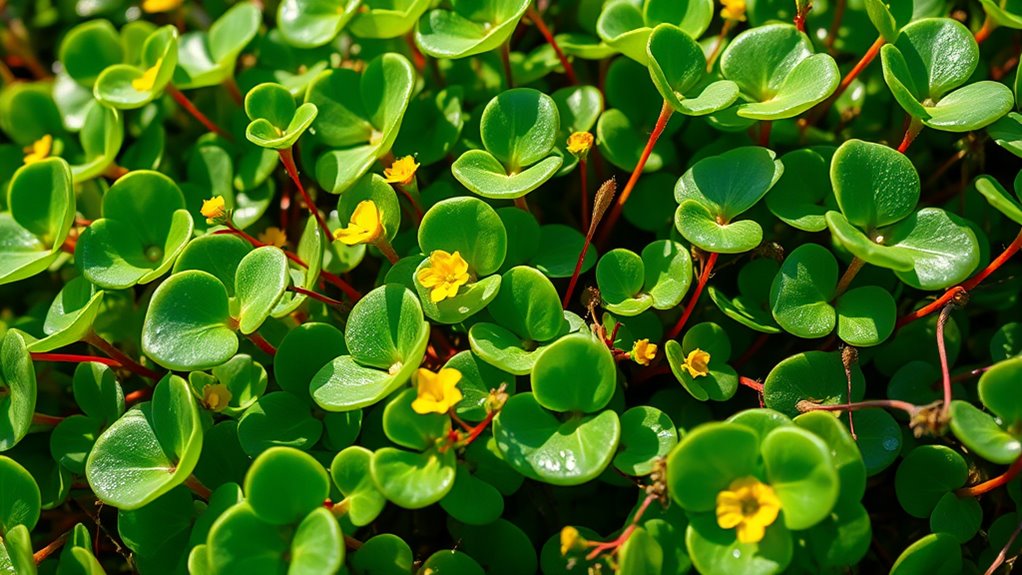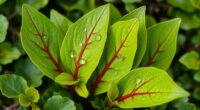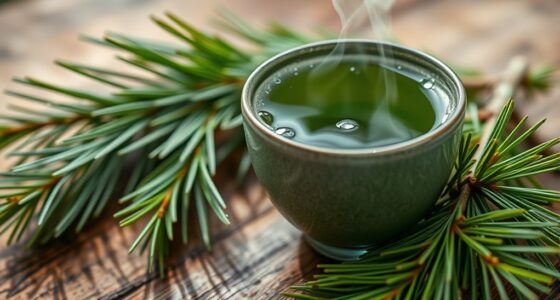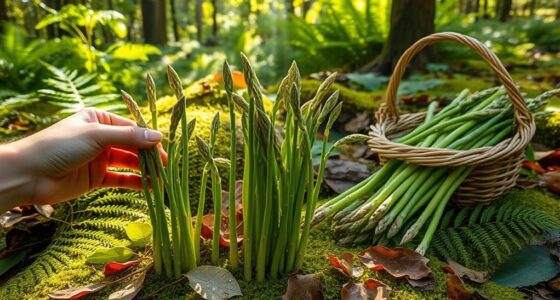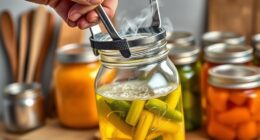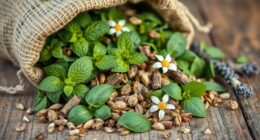To forage for purslane, look for its low, sprawling stems with a reddish tint, thick paddle-shaped leaves, and bright yellow flowers that bloom from mid-summer to fall. Find it in sunny, disturbed areas like pavements, gardens, or roadsides. Use scissors to harvest tender stems just above the roots, and always verify its identification by checking leaf shape and flower details. Stay cautious of lookalikes and contaminants. If you keep going, you’ll discover even more tips for safe harvesting and tasty preparation.
Key Takeaways
- Recognize purslane by its low-growing, reddish stems and paddle-shaped, smooth leaves, especially during summer to fall.
- Forage in sunny, disturbed areas like gardens, roadsides, and pavement cracks where purslane thrives.
- Use scissors to harvest young, tender leaves and stems just above the roots for best flavor and regrowth.
- Confirm identification by checking for small yellow flowers with 4-6 notched petals and tiny black seeds in seedpods.
- Thoroughly wash and prepare purslane by removing dirt, roots, and woody stems before culinary use.
Recognizing Purslane in the Wild
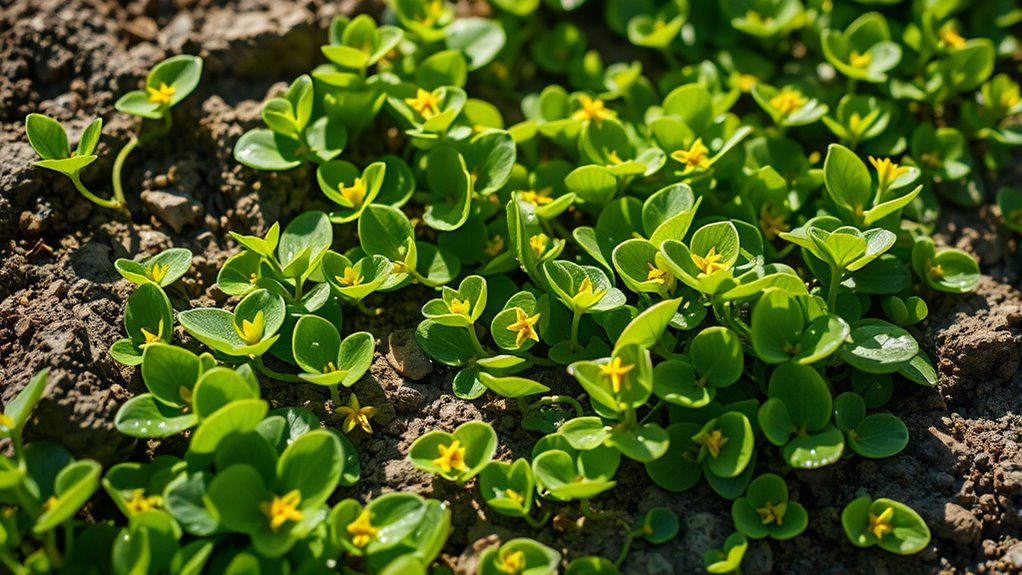
To recognize purslane in the wild, start by looking for its characteristic low-growing, prostrate stems that often have a deep red hue. These branching, succulent stems lie flat along the ground, usually under 3 inches tall, and can trail over surfaces.
Check the leaves; they’re fleshy, paddle-shaped, and smooth-edged, often arranged opposite or nearly opposite on the stems. When it flowers, small yellow blooms with five lobed petals appear from mid-summer to early fall.
Purslane thrives in disturbed areas like cracks in pavement, lawns, and gardens. It has a tapped root system that supports its water-storing, succulent nature.
Unlike some look-alikes, purslane doesn’t produce sticky latex, and its seeds are flat, round, or kidney-shaped, housed in bowl-shaped seedpods. Recognizing its succulent nature and adaptability to various environments helps distinguish purslane from similar plants.
Best Seasons and Locations for Foraging
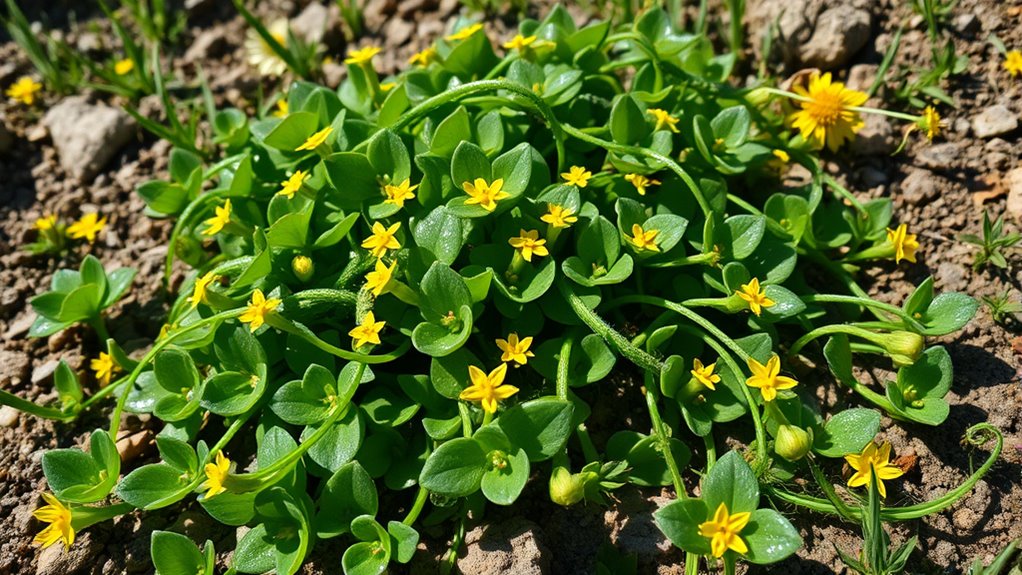
Purslane is most readily available from early summer through late fall, making these months ideal for foraging. In regions like the Midwest, it often appears in June and remains abundant until flowering begins.
Globally, it grows throughout the warm season, and in warmer climates, it can be found year-round if conditions stay favorable.
Look for purslane in sunny, open areas such as fields, gardens, roadsides, and disturbed soils like gravel or sidewalk cracks. It thrives in diverse soils and needs sufficient moisture and full sun for best growth.
Avoid foraging near polluted areas with pesticides or vehicle emissions. Purslane’s hardy nature allows it to flourish in urban settings and wild landscapes alike, ensuring good opportunities for harvest during its peak seasons.
Proper Techniques for Harvesting Purslane
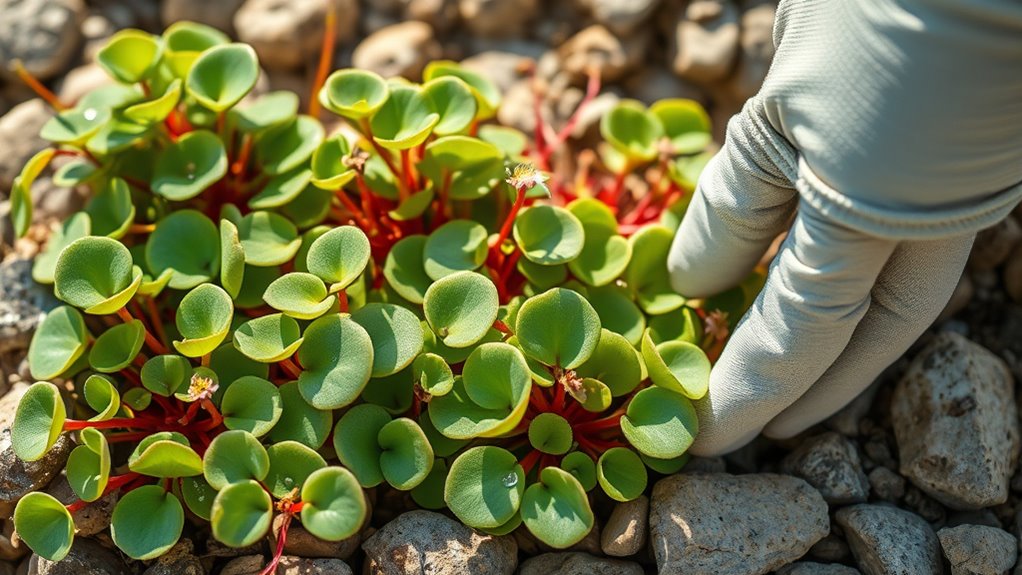
When harvesting purslane, gentle handling and proper techniques guarantee you get the freshest leaves while encouraging new growth. Use scissors or pruning shears to clip the plant, taking care not to damage the stems or leaves. Aim to harvest when the plants are young and before they start flowering, as this is when the leaves are tenderest. For a sustainable harvest, clip just above the roots, leaving them intact so new shoots can grow back. Handle the plants carefully to avoid bruising or tearing leaves. If needed, you can also pull up entire plants, but be mindful of cleaning them afterward. Regular harvesting during peak season promotes healthy regrowth and ensures a continuous supply of fresh purslane. Additionally, selecting top vacuums for hardwood floors can help keep your kitchen area clean after harvesting. Being aware of digital literacy programs can also assist seniors in learning safe and playful ways to communicate about foraged greens.
Safety Tips to Avoid Lookalikes and Contaminants
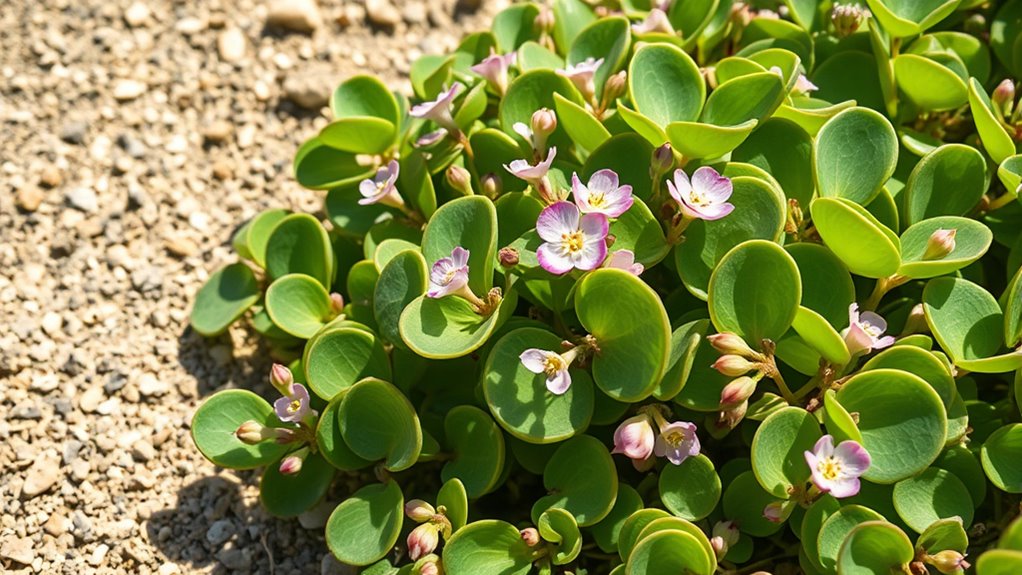
Ensuring your foraged purslane is safe begins with accurately identifying the plant and avoiding lookalikes like spurge, which can be toxic. Check that stems are thick, succulent, and often reddish, and leaves are spatula-shaped, smooth, and green with a possible reddish tint. Incorporate market trends by staying updated on popular edible greens to ensure your foraging aligns with current consumer interests. Look for small yellow flowers with 4 to 6 notched petals and tiny black seeds inside urn-shaped pods. Avoid plants that exude white latex when broken, as this indicates spurge. Use multiple identification features—stem texture, leaf shape, flower details—to confirm purslane. Proper plant identification is crucial to prevent accidental ingestion of toxic species. Regularly monitor foraging sites for toxic plants and consult local experts or guides. Being aware of vetted wild greens can help you distinguish purslane from similar-looking, potentially harmful plants. Additionally, understanding the toxicity risks associated with misidentification enhances your safety during foraging.
Preparing Purslane for Culinary Use
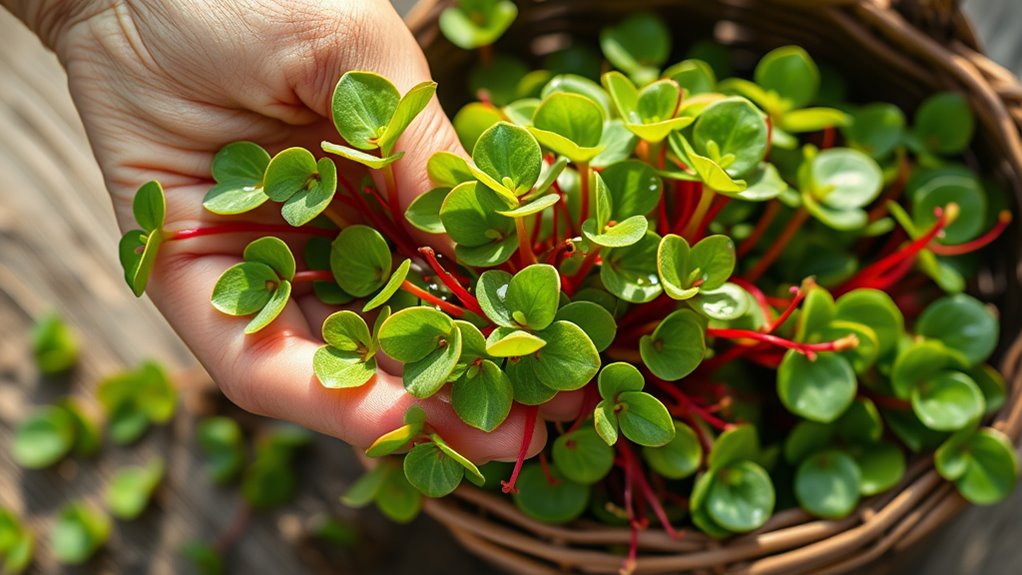
Before cooking or eating purslane, it’s essential to thoroughly clean and wash it to remove dirt, sand, and other debris. Since it grows close to the ground, dirt and grit often cling to the leaves and stems. Fill a sink with water and gently swish the purslane to loosen dirt, then repeat two to three times.
Use a salad spinner if you’re only using leaves, and rinse thoroughly to remove all soil particles. Remove roots before preparing, discarding any wilted or damaged parts.
Use only tender stems and leaves for most recipes, while woody stems can be used in soups or discarded.
Store fresh purslane in the fridge wrapped in a damp cloth, and use within a few days for ideal flavor and texture.
Sustainable Foraging and Cultivation Practices
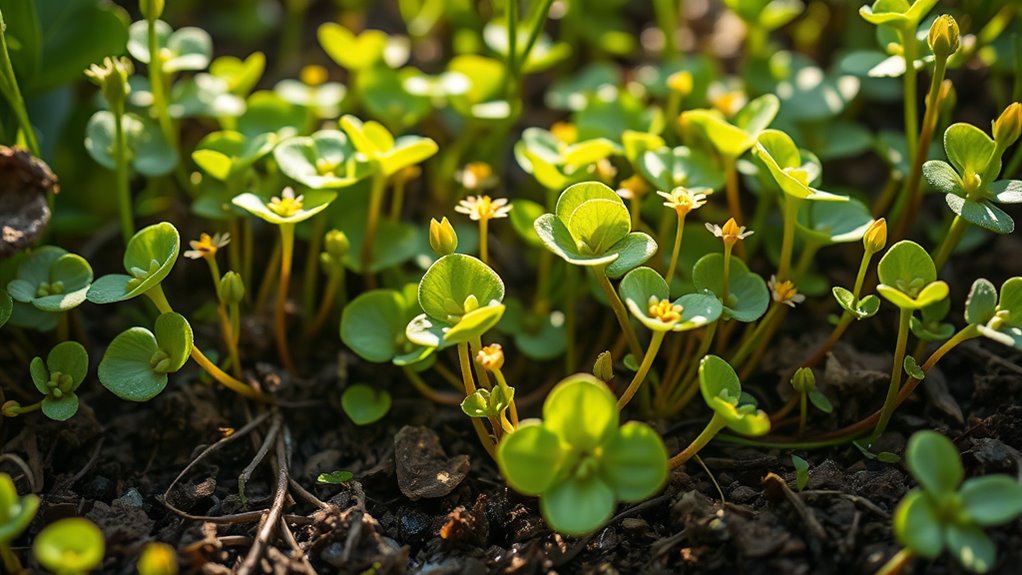
Practicing sustainable foraging and cultivation of purslane helps preserve local ecosystems and guarantees future access to this versatile plant. You should respect native ecosystems by avoiding areas with pollution or contaminants, such as pesticide-treated sites. Harvest only what you need, taking care not to damage the plant, and focus on collecting the top tips to allow continued growth. Incorporating ethical foraging practices ensures that harvesting remains environmentally friendly and sustainable. Purslane is often found in lawns, sidewalks, and disturbed areas, so selecting habitat wisely minimizes its impact on native flora. Since purslane’s impact on native species is minimal, it can be foraged responsibly with minimal ecological disruption. Use sharp scissors for clean harvesting, especially during late spring to early fall, and always identify it correctly to prevent confusion with look-alikes like spurge. Additionally, understanding local plant populations can help ensure that foraging does not negatively affect biodiversity or the health of the ecosystem. Being aware of potential threats like invasive species can further support responsible harvesting practices. Engaging in mindfulness during harvesting can promote more respectful and conscious gathering practices. Moreover, educating oneself about the social and global issues related to sustainable harvesting can foster a greater appreciation for preserving biodiversity.
Frequently Asked Questions
Can Purslane Be Eaten Raw or Should It Always Be Cooked?
You can eat purslane raw or cooked, depending on your preference. Raw purslane offers a juicy texture and is great in salads, but it contains oxalates, which might affect mineral absorption or kidney health if consumed excessively.
Cooking reduces oxalates, improves texture, and enhances flavor. For safety, enjoy it in moderation, and consider cooking if you’re concerned about oxalates or want a milder taste.
How Long Does Purslane Last After Harvesting?
Imagine a delicate green jewel that begins to lose its sparkle as time passes. After harvesting, you should store purslane in a refrigerator at around 5°C, where it can stay fresh for about 10 days.
Without proper cooling, it quickly dims, nutrients fading like a sunset. Keep it in airtight, ventilated containers to preserve its vibrant flavor and health benefits, ensuring your harvest remains a lively, nutritious addition to your meals.
Are There Any Known Allergies Related to Purslane Consumption?
You’re wondering if purslane causes allergies. While allergic reactions to purslane are rare, they can happen in some people, so watch for symptoms like itching or swelling.
It’s not a common allergen, but patch testing can help identify sensitivities. If you suspect an allergy, consult a doctor.
Can Purslane Be Grown Indoors or in Containers?
You can definitely grow purslane indoors or in containers. It needs full sun or bright indoor light, well-draining soil, and warm temperatures.
Use pots with drainage holes, space plants 1-2 feet apart, and water sparingly when the soil dries out.
Regular pruning keeps it healthy, and avoid overwatering to prevent root rot.
With proper care, your indoor purslane will thrive and provide a fresh, nutritious green.
Is Purslane Safe for Pets to Eat?
You might wonder if purslane is safe for your pets to eat. The answer is no, it isn’t safe. Purslane contains soluble calcium oxalates, which can cause serious health problems like kidney failure, weakness, and tremors in dogs, cats, and horses.
If your pet ingests purslane, you need to seek immediate veterinary help. Always keep plants with potential toxicity away from your pets to guarantee their safety.
Conclusion
Now that you know how to identify, harvest, and prepare purslane, are you ready to incorporate this nutritious wild green into your meals? With mindful foraging and respect for nature, you can enjoy its health benefits while preserving the environment. So, why not explore your local wilds and discover the vibrant, succulent taste of purslane? Embrace sustainable foraging and let this versatile plant become a tasty, eco-friendly addition to your culinary adventures.

